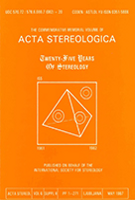On the use of complementary set fractal dimension in image analysis
Sylvain Brachotte,
Ecole Nationale Supérieure de Mécanique et des Microtechniques, Laboratoire de Microanalyse des Surfaces, 26 chemin de l’épitaphe, 25030 Besançon Cedex, France
Dominique César,
Ecole Nationale Supérieure de Mécanique et des Microtechniques, Laboratoire de Microanalyse des Surfaces, 26 chemin de l’épitaphe, 25030 Besançon Cedex, France
Claude Roques-Carmes,
Ecole Nationale Supérieure de Mécanique et des Microtechniques, Laboratoire de Microanalyse des Surfaces, 26 chemin de l’épitaphe, 25030 Besançon Cedex, France
Abstract
The distribution of objects viewed in the same plane is oflen observed in materials science. When the structure of objects, or that of their distribution remains invariant, whatever the observation range may be, using fractal metrology can be worthwhile.
For this purpose, a "distribution index", independant of the regularity in shape of each object can be proposed.
This distribution index is defined as the convergence exponent of a family of adjacent geometrical elements (disks, squares, losanges...) used to describe the Apollonian packing of the residual set E of the objects.
This characterization has been applied with success to metal, mineral or biological materials for different applications working energy transfers at the interfaces.
Keywords : apollonian packing, Besicovitch-Taylor index, complementary set fractal dimension, corrosion pits, residual set of objects
To cite this article
Sylvain Brachotte, Dominique César & Claude Roques-Carmes, «On the use of complementary set fractal dimension in image analysis», Acta Stereologica [En ligne], Volume 14 (1995), Number 2 - Quantitative image analysis - Nov. 1995, 129-136 URL : https://popups.uliege.be/0351-580x/index.php?id=754.
